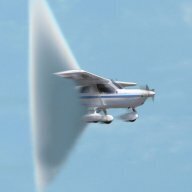I recently went down to Lethbridge for conversion to their Tecnam P92E with Golden Plains Flying School CFI Bruce Vickers.
The first difference that I saw upon entering the cockpit was the floor mounted control sticks. Under the cowl, the 100 horsepower engine is partially air/partially liquid cooled with no carby heat, and is some 15 horses bigger than the Jab's. It has an all-flying elevator and very large flaps. I was relieved to see that it had two throttles (one high on the left like a Jabiru, and one low in the centre like a Cessna). I immediately put my left hand on the throttle. Bruce saw this and said, "I'm going to get you to use the centre one with your right hand, so you can get used to flying different types of aircraft. It will feel different at first, but I guarantee that by the time you turn downwind you won't even give it another thought." He was right!
We strapped in and went through the checklists (which Bruce had programmed into the Dynon D100 EFIS - a nice touch). I was introduced to the slightly different starting considerations with this engine, then we taxied over to the cement slab for the run up. Water temperature was close to optimal, but the oil had a little way to go. Bruce explained that this would be up by the time we taxi to the end of the runway. I released the parking brake and we trundled off to the start of runway 29.
Flying this Tecnam is a breeze. It climbs very well, even though we were two-up with full fuel. We departed crosswind and headed out to the West for some upper air work. I found during the turns that I was well over using the rudder. My feet would add in the same amount of rudder for the Jabiru, and I'd look down to see the ball waaaay out one way. It took a couple of minutes to rid my turns of this, but eventually I was affecting nicely balanced turns. We then moved on to stalls, with emphasis on stalls during turns as this aircraft does not have a stall warning horn.
Upon returning to the circuit area, I accidentally closed my radio call with my usual 'Ballarat'. Oops! I quickly got back on the button and amended it. Bruce laughed a little and said "That's ok, we've all done it!" We went through the various approaches - flapped and flapless - glide and power assisted. The first landing I attempted was a flapless full glide approach. I was flying the numbers that I am used to seeing in the Jabiru and came down to find that the elevator was very responsive all the way through the hold off - ending in a real greaser! Wow. This aircraft makes me look like a much better pilot than I really am! I was then told to do a flapped approach. This was not too dissimilar, but the maximum flap extension speed is 63 knots - meaning that you really have to work to slow the aircraft down before deploying them!
I came in again, this time at 57 knots, flared, held off, held off, held off, held off.... I snuck a quick peek at the airspeed... 38 knots, and it was still trying to fly! I think it eventually touched down at 36 or so knots. Amazing stuff that you wouldn't see in the J-160 with it's high wing loading. The circuits continued for some time, when Bruce started introducing practice emergency procedures. Engine failure after takeoff, engine failure in the circuit, etc. He then demonstrated a rather impressive short field landing. After that he said, "You are doing really well. We'll stop for a lunch break and after that we'll do one or two more circuits and then I'll send you solo."
Wow. It was like my first solo all over again. But then I thought, "Wait... This is nothing like my first solo. I can do this!"
Bruce explained that there was a student coming in a few minutes, so do two circuits and we'll talk when you're done." With that, he got out and shut the door. I was amazed again by the climb performance of this aircraft. I reached 500 feet and prepared for my turn to crosswind, when it struck me that I was still able to see the end of the runway in front of the cowl! Had this thing gone straight up? It certainly felt like it.
I decided to make use of my two circuits effectively, by doing one flapless approach and one flapped. The flapless was fairly unremarkable, but the flapped one had a bit of excitement. The aircraft is difficult enough to slow down when two-up, it is even more difficult when solo. I had eaten up so much time trying to reign it in that I ended up a little high. I finally saw the speed I wanted and got the flaps down. I ended up landing a little long on the runway, but I was easily slowed to taxi speed by the runway intersection.
I parked it in the same place that I found it earlier that day and shut the engine down. We then went into the office for a debrief. Bruce said he was very happy with my handling of the aircraft, and my workcycles are clearly working. He added that normally he's looking for somewhere between two and three hours for a conversion, but he was happy to sign me off at 1.7 hours! So, for my logbook I have 1.4 dual and 0.3 pilot in command of a Tecnam P92E.
It was worth every minute! Not only for the extra experience, but for the extra time with a different instructor and now I'm 'on the books' at two different schools. I can now rent either aircraft at any time.










